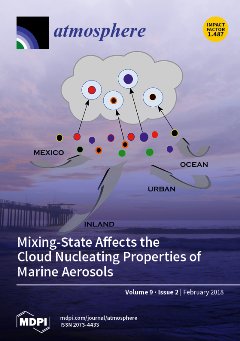Recurrent personal exposure to ambient PM
2.5 is associated with adverse human health effects, in particular on the respiratory and cardiovascular systems. Here, we present an assessment of personal exposure and inhalation of PM
2.5 for five modes of transport (walking, cycling, public
[...] Read more.
Recurrent personal exposure to ambient PM
2.5 is associated with adverse human health effects, in particular on the respiratory and cardiovascular systems. Here, we present an assessment of personal exposure and inhalation of PM
2.5 for five modes of transport (walking, cycling, public bus (trolleybus and diesel bus), conventional car (CC) and hybrid-electric car (HEC)) and two routes of similar distance, along a major road in the Mexico City metropolitan area (MCMA). Arithmetic average exposure concentrations ranged from 16.5 ± 6.5 µg m
−3 for walking to 81.7 ± 9.1 µg m
−3 for cycling (henceforth shown as average ±1 SD), with no significant differences with geometric averages. The maximum exposure concentration of 110.9 µg m
−3 was observed for the conventional car. The highest exposure concentrations depended on route and the mode of transport, being observed for cycling and walking. The PM
2.5 measurements showed large spatial heterogeneity in the exposure levels for walking and cycling, while public buses and private transport showed less spatial heterogeneity. The greatest peaks in PM
2.5 coincided with 4-way intersections for all modes of transport, being positively influenced by traffic density. The mass of PM
2.5 inhaled depended mostly on the mode of transport, and ranged between 1.0 ± 0.3 and 30.1 ± 14.2 µg km
−1 for the HEC and bicycle, respectively. Local area PM
2.5 increments identified as ‘residuals’ after subtraction of data recorded at the closest fixed monitoring site from exposure concentrations along the studied road suggested that inhalation for bicycle and diesel buses is strongly influenced by vehicular emissions. Residuals estimated for the trolleybus, CC and HEC confirmed a lower inhalation than for the other modes of transport evaluated due to protection by the cabin.
Full article





